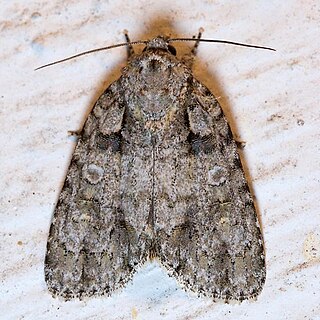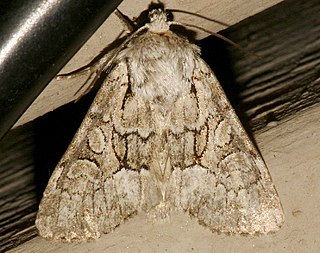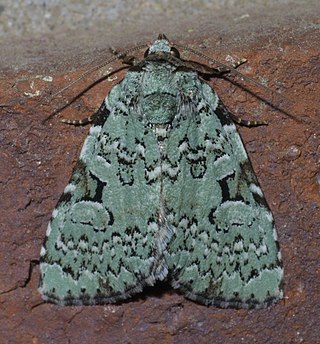
Acronicta increta, the raspberry bud dagger moth, raspberry bud moth or peach sword stripe night moth, is a moth of the family Noctuidae. The species was first described by Herbert Knowles Morrison in 1875. It is distributed throughout the south of Canada and the United States down to Florida and Texas.
Acopa is a genus of moths of the family Noctuidae. The genus was erected by Leon F. Harvey in 1875.

Annaphila is a genus of moths of the family Noctuidae. The genus was erected by Augustus Radcliffe Grote in 1873.

Cirrhophanus is a genus of moths of the family Noctuidae. The genus was erected by Augustus Radcliffe Grote in 1872.

Copivaleria is a monotypic moth genus of the family Noctuidae erected by Augustus Radcliffe Grote in 1883. Its only species, Copivaleria grotei, or Grote's sallow, was first described by Herbert Knowles Morrison in 1874. It is found in eastern North America, including Ontario, Tennessee, New York and Maryland.
Emarginea is a genus of moths of the family Noctuidae. The genus was erected by Achille Guenée in 1852.<

Eremobina is a genus of moths of the family Noctuidae erected by James Halliday McDunnough in 1937.
Fala is a monotypic moth genus of the family Noctuidae. Its only species, Fala ptycophora, is found in the US state of California. Both the genus and species were first described by Augustus Radcliffe Grote in 1875.

Grotella is a genus of moths of the family Noctuidae first described by Leon F. Harvey in 1875.
Haplostola is a monotypic moth genus of the family Noctuidae. Its only species, Haplostola aphelioides, is found in Puerto Rico. Both the genus and species were first described by Heinrich Benno Möschler in 1890.

Leuconycta is a genus of moths of the family Noctuidae. The genus was first described by George Hampson in 1909.

Mamestra is a genus of moths of the family Noctuidae described by Ochsenheimer in 1816. Perhaps the best known species is the cabbage moth, M. brassicae.
Periscepta is a genus of moths of the family Noctuidae. The genus was described by Turner in 1920.

Plagiomimicus is a genus of moths of the family Noctuidae. The genus was erected by Augustus Radcliffe Grote in 1873.

Psaphida is a genus of moths of the family Noctuidae. The genus was erected by Francis Walker in 1865.

Pseudorgyia is a genus of moths in the family Erebidae. The genus was erected by Leon F. Harvey in 1875.
Sinocharis is a monotypic moth genus of the family Noctuidae. Its only species, Sinocharis korbae, is found in south-eastern Siberia and Japan. Both the genus and species were first described by Püngeler in 1912.

Spragueia is a genus of moths of the family Noctuidae. The genus was erected by Augustus Radcliffe Grote in 1875.

Tarache is a genus of moths of the family Noctuidae erected by Jacob Hübner. It includes most former New World Acontia species. Lepidoptera and Some Other Life Forms and The Global Lepidoptera Names Index report this name as a synonym of Acontia.

Globia laeta, the red sedge borer, is a moth of the family Noctuidae. The species was first described by Herbert Knowles Morrison in 1875. It is found in North America, including Ohio, Illinois, New Jersey and Ontario.













